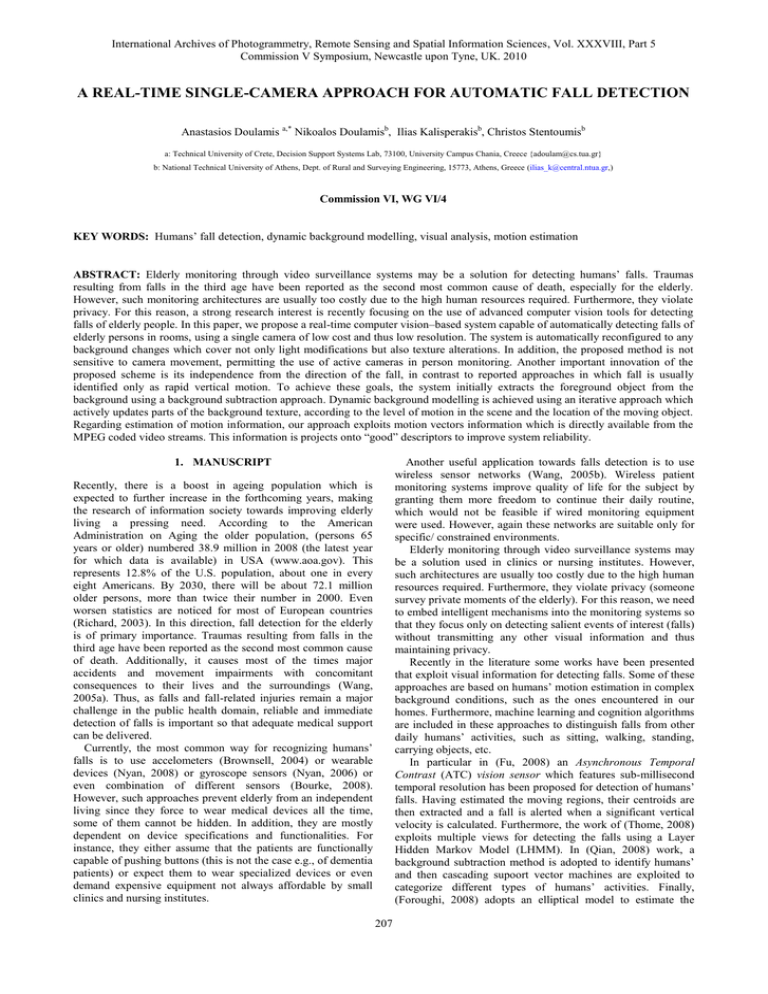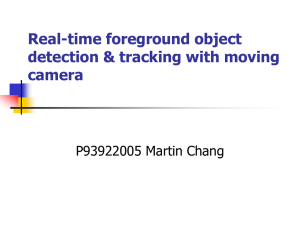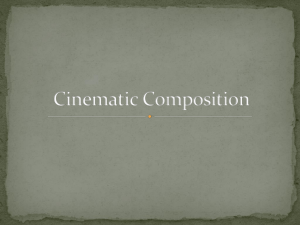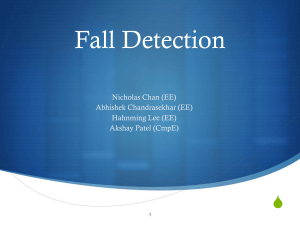International Archives of Photogrammetry, Remote Sensing and Spatial Information Sciences,...
advertisement

International Archives of Photogrammetry, Remote Sensing and Spatial Information Sciences, Vol. XXXVIII, Part 5
Commission V Symposium, Newcastle upon Tyne, UK. 2010
A REAL-TIME SINGLE-CAMERA APPROACH FOR AUTOMATIC FALL DETECTION
Anastasios Doulamis a,* Nikoalos Doulamisb, Ilias Kalisperakisb, Christos Stentoumisb
a: Technical University of Crete, Decision Support Systems Lab, 73100, University Campus Chania, Creece {adoulam@cs.tua.gr}
b: National Technical University of Athens, Dept. of Rural and Surveying Engineering, 15773, Athens, Greece (ilias_k@central.ntua.gr,)
Commission VI, WG VI/4
KEY WORDS: Humans’ fall detection, dynamic background modelling, visual analysis, motion estimation
ABSTRACT: Elderly monitoring through video surveillance systems may be a solution for detecting humans’ falls. Traumas
resulting from falls in the third age have been reported as the second most common cause of death, especially for the elderly.
However, such monitoring architectures are usually too costly due to the high human resources required. Furthermore, they violate
privacy. For this reason, a strong research interest is recently focusing on the use of advanced computer vision tools for detecting
falls of elderly people. In this paper, we propose a real-time computer vision–based system capable of automatically detecting falls of
elderly persons in rooms, using a single camera of low cost and thus low resolution. The system is automatically reconfigured to any
background changes which cover not only light modifications but also texture alterations. In addition, the proposed method is not
sensitive to camera movement, permitting the use of active cameras in person monitoring. Another important innovation of the
proposed scheme is its independence from the direction of the fall, in contrast to reported approaches in which fall is usually
identified only as rapid vertical motion. To achieve these goals, the system initially extracts the foreground object from the
background using a background subtraction approach. Dynamic background modelling is achieved using an iterative approach which
actively updates parts of the background texture, according to the level of motion in the scene and the location of the moving object.
Regarding estimation of motion information, our approach exploits motion vectors information which is directly available from the
MPEG coded video streams. This information is projects onto “good” descriptors to improve system reliability.
Another useful application towards falls detection is to use
wireless sensor networks (Wang, 2005b). Wireless patient
monitoring systems improve quality of life for the subject by
granting them more freedom to continue their daily routine,
which would not be feasible if wired monitoring equipment
were used. However, again these networks are suitable only for
specific/ constrained environments.
Elderly monitoring through video surveillance systems may
be a solution used in clinics or nursing institutes. However,
such architectures are usually too costly due to the high human
resources required. Furthermore, they violate privacy (someone
survey private moments of the elderly). For this reason, we need
to embed intelligent mechanisms into the monitoring systems so
that they focus only on detecting salient events of interest (falls)
without transmitting any other visual information and thus
maintaining privacy.
Recently in the literature some works have been presented
that exploit visual information for detecting falls. Some of these
approaches are based on humans’ motion estimation in complex
background conditions, such as the ones encountered in our
homes. Furthermore, machine learning and cognition algorithms
are included in these approaches to distinguish falls from other
daily humans’ activities, such as sitting, walking, standing,
carrying objects, etc.
In particular in (Fu, 2008) an Asynchronous Temporal
Contrast (ATC) vision sensor which features sub-millisecond
temporal resolution has been proposed for detection of humans’
falls. Having estimated the moving regions, their centroids are
then extracted and a fall is alerted when a significant vertical
velocity is calculated. Furthermore, the work of (Thome, 2008)
exploits multiple views for detecting the falls using a Layer
Hidden Markov Model (LHMM). In (Qian, 2008) work, a
background subtraction method is adopted to identify humans’
and then cascading supoort vector machines are exploited to
categorize different types of humans’ activities. Finally,
(Foroughi, 2008) adopts an elliptical model to estimate the
1. MANUSCRIPT
Recently, there is a boost in ageing population which is
expected to further increase in the forthcoming years, making
the research of information society towards improving elderly
living a pressing need. According to the American
Administration on Aging the older population, (persons 65
years or older) numbered 38.9 million in 2008 (the latest year
for which data is available) in USA (www.aoa.gov). This
represents 12.8% of the U.S. population, about one in every
eight Americans. By 2030, there will be about 72.1 million
older persons, more than twice their number in 2000. Even
worsen statistics are noticed for most of European countries
(Richard, 2003). In this direction, fall detection for the elderly
is of primary importance. Traumas resulting from falls in the
third age have been reported as the second most common cause
of death. Additionally, it causes most of the times major
accidents and movement impairments with concomitant
consequences to their lives and the surroundings (Wang,
2005a). Thus, as falls and fall-related injuries remain a major
challenge in the public health domain, reliable and immediate
detection of falls is important so that adequate medical support
can be delivered.
Currently, the most common way for recognizing humans’
falls is to use accelometers (Brownsell, 2004) or wearable
devices (Nyan, 2008) or gyroscope sensors (Nyan, 2006) or
even combination of different sensors (Bourke, 2008).
However, such approaches prevent elderly from an independent
living since they force to wear medical devices all the time,
some of them cannot be hidden. In addition, they are mostly
dependent on device specifications and functionalities. For
instance, they either assume that the patients are functionally
capable of pushing buttons (this is not the case e.g., of dementia
patients) or expect them to wear specialized devices or even
demand expensive equipment not always affordable by small
clinics and nursing institutes.
207
International Archives of Photogrammetry, Remote Sensing and Spatial Information Sciences, Vol. XXXVIII, Part 5
Commission V Symposium, Newcastle upon Tyne, UK. 2010
shape of humans’ body and then exploits support vector
machines to categorize these shapes as falls or other humans’
activities.
However, these algorithms either assume static background
models which perform poorly when dynamic changes of the
background are encountered (as is the case of real–life
situations), or exploit multiple camera information to define
human’s height and consequently his/her fall. Furthermore, the
computational complexity of some of the aforementioned
systems is high, preventing the real-time performance which is
necessary for large scale implementation. Fall should be
detected in real time (or almost in real time) but also not be
confused with other actions (sitting, bending or even
leaving/entering the camera view). Furthermore, specific
directions of the falls are assumed, usually perpendicular to the
camera view which is too restrictive for real life applications. In
a real world surveillance system, a person can move in all
directions of the room, and thus his/her fall does not necessarily
imply vertical motions. Besides, the system should be robust to
any background change and thus demand minimum reconfiguration to dynamic changes of the environment and
lighting conditions.
In (Doulamis N., 2010) a visual fall detection scheme has
been proposed using an iterative motion estimation algorithm
which is constrained by time and shape rules. The concept
behind this paper is that humans’ motion should be coherent
and thus any significant modification in motion and shape of the
tracked objects should re-force a new estimation of the visual
background conditions unless a fall is detected. Thus,
(Doulamis N., 2010) work is sensitive to environmental changes
and it can be only applicable for slightly modified backgrounds,
while the algorithm fails in case of occlusions, or presence of
multiple persons. A more robust approach for extracting
foreground objects from background in more complicated visual
conditions have been proposed in (Doulamis A., 2010). This
work uses adaptive boosting strategy (adaboost) to model the
visual statistics of the background/foreground objects and thus
improving the visual analysis. However, the work of (Doulamis
A., 2010) does not directly deal with fall detection while it
assumes a limited number of foreground objects and thus it is
not suitable for the persons’ fall application scenario.
In this paper, we propose a real-time computer vision–based
system capable of automatically detecting falls of elderly
persons in rooms, using a single camera of low cost and thus
low resolution. The system is automatically reconfigured to any
background changes which cover not only light modifications
but also texture alterations. In addition, the proposed method is
not sensitive to camera movement, permitting the use of active
cameras in person monitoring. Another important innovation of
the proposed scheme is its independence from the direction of
the fall, in contrast to reported approaches in which fall is
usually identified only as rapid vertical motion.
The first component of the proposed system is the automatic
extraction of the foreground object from the background. This is
performed using a background subtraction approach, enriched
with on-line learning strategies able to work in highly dynamic
scenes. Dynamic background modelling is achieved using an
iterative approach which actively updates parts of the
background texture, according to the level of motion in the
scene and the location of the moving object. This is achieved
using non-linear approaches for modelling the background such
as the Learning Vector Quantization. This technique is very fast
and thus background modelling can be calculated in real-time.
Regarding estimation of motion information, our approach
exploits MPEG coded motion vectors so as to minimize the cost
in computing the iterative algorithm since n decoding is
required. However, MPEG motion vectors are estimated for
coding purposes and not for analysis and thus they are very
sensitive to noise (Doulamis, 2000). For this reason, we
estimate only the most confident motion vectors as the ones
derived using edge-based information. Towards this direction,
the Shi-Tomasi algorithm is taken into account (Shi, 1994).
Selection of good features increases the robustness in detecting
motion in a scene. On the contrary, application of conventional
motion detector methodologies to the all image pixels would
result in motion vectors of significant magnitude in regions
where no real motion exists due to slightly camera adjustments
and lighting conditions.
More specifically, in case that a large connected component
of motion is detected in the scene the background is
dynamically updated. In particular, all non-moving regions are
considered as the new background candidate and therefore this
information is accumulated to the existing background models.
On the contrary, the moving regions are considered intact.
The second component of the proposed system is responsible
for detecting a human’s fall by exploiting the dynamic
foreground localization and tracking methodology described
above. The main difficulty in this case is the need to distinguish
human’s falls from other regular human activities (sitting,
bending). In particular, the goal is to minimize false positive
and false negative results and thus significantly increase the
reliability of the fall detection system, making it applicable to
real world conditions. This is even more challenging under a
single camera system due to the geometric limitations in depth
reconstruction as compared to stereovision.
2. FOREGROUND EXTRACTION
The first step of the proposed Person Fall Detection sensor is
the extraction and robust tracking of the foreground object.
However, robust and continuous foreground detection is a very
challenging research task, especially in real-life application
scenarios where complex and dynamic background conditions
are encountered. Usually, foreground extraction is
accomplished using background modelling methods followed
by background subtraction techniques. In this paper, we extract
foreground object using classification based background
modelling approaches, which are described in the following.
2.1 Classification Background Modelling
In this paper, we model the background visual statistics a
modification of the algorithms of (Heikkila, 1999) using nonlinear learning strategies as if of Learning Vector QuantizationLVQs (Kohonen, 2001).
According to (Heikkila, 1999), let us denote as I(t) an image
(or a video frame) at a time instance t. Let us also denote as B(t)
the background region at the same tine t. Then, an image pixel
is said to belong to a foreground region if
I (t ) B (t )
(1)
where τ is a predefined threshold. Morphological 3x3 closing
operators can be applied on (1) to remove noisy pixels and thus
improve the accuracy detection. Then, the background is
updated as
B(t 1) aI (t ) (1 a) B(t )
(2)
where a is kept small to prevent artificial prevent artificial
“tails” forming behind moving objects.
208
International Archives of Photogrammetry, Remote Sensing and Spatial Information Sciences, Vol. XXXVIII, Part 5
Commission V Symposium, Newcastle upon Tyne, UK. 2010
w k x w i x , for all i
Then, two background corrections are applied:
1. If a pixel is marked as foreground for more than m of the
last M frames, then the background is updated as B(t)=I(t). This
correction is designed to compensate for sudden illumination
changes and the appearance of static new objects.
2. If a pixel changes state from foreground to background
frequently, it is masked out from inclusion in the foreground.
This is designed to compensate for fluctuating illumination,
such as swinging branches.
the dependence of the mi on the iterations of the algorithm.
Then, picking up a random sample x and denoting as m k ` (n)
the best (closest) representative for this sample at the nth
iteration of the algorithm, then, this representative is updated so
that
(4)
mk (n 1) mk (n) (x mk (n))
while the other representatives remain intact. Parameter μ
defines the convergence rate for achieving optimality.
This algorithm, however, is very sensitive to illumination
changes, although it is very simple. For this reason, we modify
it in this paper introducing non-linearlities via a learning vector
quantization algorithm. This way, we group together similar
statistics of the background reducing noisy oscillations from
frame to frame and while keeping the computational complexity
as low as possible. The main characteristic of the LVQ
algorithm is its ability to be implemented in real time making
the proposed humans’ fall detection algorithm applicable in
real-life conditions.
2.1.1
(3)
In particular, the algorithm starts at the 0th iteration in which
it assumes that K representative codebooks have been randomly
derived, denoting as mi (0) where in this case we have added
Main Steps of the Proposed Hybrid Algorithm
1.
2.
3.
Background Modeling Using on-Line Learning
4.
Let us assume that we have available the color statistics for
the background. The exact way on how we perform this
automatically is described in Section 3. Then, the proposed
scheme aims at learning these background statistics dynamically
as new content is being captured so as to classify these regions
as background or foreground areas. Let as denote as Sb(t) the
training set of the background at a time instance t. In this paper,
the training set expresses color information of background
region.
Given the set Sb(t), one can estimate a number of classes
(color representatives) that they model as much as possible the
visual characteristics of the background, as is described by Sb(t).
Let us denote as mi, with i=1,2,…,K the K representatives for
the background. The optimal number for mi can be estimated
through the generalized Lloyd-Max algorithm. This algorithm
can be implemented through the k-means (Tan, 2005).
The k-means implementation for the Lloyd Max algorithm
actually handles the incoming data in a batch mode. This means
that it groups together background regions that share common
color properties without taking more in account the current
statistics than the previous ones. That is, it defines the K color
representatives around which the background pixels will be
related.
Another dynamic implementation for the mi representatives
is through Learning Vector Quantization (LVQ). LVQ is one
example of competitive learning. The goal here is to have the
network "discover" structure in the data by finding how the data
is clustered. In vector quantization, we assume there is a
codebook which is defined by a set of M prototype vectors (M is
chosen by the user and the initial prototype vectors are chosen
arbitrarily). An input belongs to the ith cluster if i is the index
of the closest prototype (closest in the sense of the normal
Euclidean distance). This has the effect of dividing up the input
space into a Voronoi tessellation. In particular, in LVQ
approach, we randomly pick one sample out of the available
ones. Then, we find the “winning” node for this sample, i.e., the
cluster whose the distance from this sample is smaller than any
other distance with other clusters, meaning that the selected
sample and the respective node winner node if the optimal
choice we can made at this stage of the algorithm. Then, we
update the weights for the winning cluster to take into account
this new information.
5.
6.
Take a set of M previous backgrounds.
Assume that the representatives for these backgrounds are
available
Group each incoming sample with respect to these
representatives
If some samples within a group deviates a lot create a new
group
Update the representative values using the LVQ
methodology
Merge groups whose representatives are too close
Table 1. Summary of the main steps of the proposed hybrid
scheme for estimating background representatives.
In our case, the background content can be dynamically
modified. Thus, for each captured frame a new background set
Sb(t) is estimated. If we take into account only the statistics for
the current background, then we totally ignore (forget) the
previous information which may be important for future
background samples. Suppose for instance a background object
which is fully occluded by humans as they are randomly
walking in the surveyed area. If we would forget the previous
samples, then we cannot recall the color statistics for this object
so as to correctly categorize the background even for future
information.
In this paper, we adopt a hybrid methodology which
appropriately modifies the previous knowledge exploiting online learning methodologies. Let us assume that M previous
backgrounds are available. Then, their statistical properties can
be included in sets Sb(t), Sb(t-1), Sb(t-2),…, Sb(t-M). For each of
the previous backgrounds, we have estimated some
representatives using the proposed algorithm. We should
mention that the number of representative vectors per
background is not constant since this actually depends on
dynamicity of the content. Then, each new incoming sample is
grouped with respect to these representatives. These groups are
merged or split with respect to algorithm proposed in Section
2.1.2. Then, we update the values of the representative samples
using the LVQ algorithm
2.1.2
Automatic Estimate of the Number of Representatives
If the distance of a picked sample is far away from all K
representatives, a new representative is created since this means
that the sample cannot be described by any of the existing
codebooks. In this case, we set the new representative equals
the new sample and we follow as in Section 2.1.1.
Similarly, if the values of two representatives are too close
we remove one of the two since they refer to almost similar
content. Between the two, we remove the representative that
209
International Archives of Photogrammetry, Remote Sensing and Spatial Information Sciences, Vol. XXXVIII, Part 5
Commission V Symposium, Newcastle upon Tyne, UK. 2010
less describes the variations and information of all samples
assigned to it. This way, we automatically update the number of
representative per background area. Table 1 summarizes the
main steps of the proposed algorithm.
To improve motion analysis in this paper, we project motion
information onto “good” (“feasible”) descriptors. This way,
instead of calculating the whole motion information in an
holistic approach we restrict this analysis on motions that
present high probability of being foreground region, rather than
on areas that seems to be background.
Towards a feature-based selection, we use the algorithm of
(Shi, 1994). Good descriptors are, for example, the corners in
an image, the locations of zero crossing of the image Laplacian,
the standard deviation in the spatial intensity, etc. However,
even a region is rich in texture information can be poor in
tracking. For instance, it can straddle a depth discontinuity or a
boundary of a light reflection. Even worst, the good features can
be also occluded and the trackers can be drifted far away from
their original target.
For this reason, in this paper, we implement the work of
(Shi, 1994) on corners. In particular, we initially calculate the
minimal eigenvalue for every pixel of the source image and then
performs non-maxima suppression around a neighboring area
(in our case an area of 3x3 neighboring block is selected). The
next step is to filter out the corners from possible noise. Thus,
we exclude from the features the corners that present minimal
eignevalues less than a preset threshold activity.
3. CONFIDENT SELECTION OF THE BACKGROUND
SAMPLES
In this section, we describe an algorithm that estimates the most
confident regions in an image that should be characterized as
background. This is accomplished by collecting a set of images
(video frames) which localise the foreground region and thus
they indirectly refer to the background. It should be mentioned
that we pay no particular attention on whether foreground
objects are present when the background modelling algorithm is
activated. These objects will be actually removed from the scene
due to the dynamic nature of our method. This constitutes the
main innovation of the proposed algorithm; the background can
be dramatically changed from time to time and despite that the
proposed scheme is able to be adapted to the new conditions
(after the elapse of some frames). As a result, it is probable for
some frames (especially right after a major change of the
background content) to derive a rough approximate description
4. HUMANS’ FALLS DETECTION
3.1 Creating the background Samples
Detection of vertical motion trajectories for estimating humans’
falls as adopted in (Fu, 2008) significantly restricts humans’
position in the visual environment and the way that the fall
takes place. Usually, when survey a room we place single
cameras on the top corners of the columns and it quite probable
the fall to take place in other than vertical positions with respect
to the camera. Humans’ are not walking in front of cameras.
Instead, they are passing throughout the room in arbitrarily
directions and falls can occur either across, or in an oblique
way.
In addition, the recognition of a fall from the objects shape
(Foroughi, 2008) is sensitive to the optical parallax that the
object is be seen by the camera. Even in the seldom case that
the fall will occur vertically to cameras’ view, humans’ shape is
totally different if he/she falls towards the camera (dramatic
reduction of the shape) or in the opposite direction to the view.
This means in, other words, that it is probable to confuse a fall
with another regular humans’ activity, i.e., sitting. To be sit in a
chair towards cameras’ view can be too similar to fall in the
opposite way. More complicated effects on humans’ shape can
be encountered in the usual case that falls are oblique or even
horizontal with respect to the visual view.
To address this difficulty, in this paper, we estimate the fall
by following the trajectory of the upper boundary of the
foreground object. This criterion is much more sensitive to
human fall events. In particular, let us denote as y (t ) the
vertical position of the upper boundary of the detected
foreground object at time t. Then, we define the vertical velocity
(acceleration during the fall ) as the time derivative
The main difficulty of the aforementioned approach is the
automatic estimation of the set of background region statistics,
or in other words, the automatic estimation of the background
region. In this paper this is achieved indirectly by firstly
detecting the foreground region and then estimating the
background as the complementary set of the foreground.
For the foreground object, we assume that it possess the
largest portion of motion activity. Of course, parts of the
background can be moved in such a dynamic environment
(either due to periodic oscillation, or due to sensitivity in
capturing noise, or even due to dramatic environmental
changes,-illumination changes, background objects that are
moving, etc). However, the largest and most coherent part of
moving activity is for the foreground object. In the following,
we exploit such property to identify the foreground region in a
frame and then indirectly the background area.
The motion vector information as being directly available
from the Moving Picture Expert Group (MPEG) compression is
exploited in this paper as an indicator of motion activity. Other
information can be used instead of motion vectors, as if the
optical flow. However, motion vectors are available without
requiring to decode the MPEG video streams. This saves
computational complexity and storage capabilities.
Motion vectors are available for P and B frames of MPEG
sequences. For the I frames one can estimate the moving
information using knowledge from the previous and the
following P/B frames.
It is clear that MPEG motion vectors have been estimated
coding purposes and not for a moving region segmentation.
This means that they present high noise as far as the actual
objects’ motion is concerned. In MPEG coding, motion vectors
are embedded in video streams along with compensation errors
so as to reduce the information needed to be stored by
exploiting motion activities. As a result, even random motion
vectors can be useful for decoding purposes (of course no
efficient) since the compensation error (in this case, it takes
large values) can correct any mistake in actual motion
estimation. On the other hand, these values are not proper for
detecting the moving information for a foreground region.
J
y (t 1) y (t )
dt
(5)
It is clear that the aforementioned equation presents a
measure of how the foreground object is changing through time.
Thus, it can be considered as a measure for fall alert.
The main problem of (5) is that it does not take into account
the size of the human object. It is clear, however, that human
objects close to the camera are bigger than object far from the
210
International Archives of Photogrammetry, Remote Sensing and Spatial Information Sciences, Vol. XXXVIII, Part 5
Commission V Symposium, Newcastle upon Tyne, UK. 2010
camera. Thus, we need to face differently each of these objects.
For this reason, we normalize y (t ) with respect to the initial
detected foreground height.
J
[ y (t 1) y (t )] / y (t )
dt
background can be extracted with high accuracy in all cases.
We also observe from Figure 3 that gradually the background is
updated with the current objects (as if the door) improving the
fall detection accuracy.
This is more evident in Figure 4 in which at a time the
camera is moving and the background significantly changes, We
can see that the proposed algorithm is very robust and it can
detects the background even in such dramatic changes within
very few frames. In addition, despite the complexity of the
background content the algorithm remains very stable.
(6)
Equation (6) can be seen as a proper metric for falls
detection. The experimental results that we propose in Section 5
show the advantage of this method in recognizing falls in
complicated visual environments.
5. EXPERIMENTAL RESULTS
Initially, we test the performance of the proposed algorithm in
our lab using two different types of experiments. In the first
experiment, the background is modified by moving objects in it.
In the second experiment, the camera is moving to severely
change the background visual conditions. Figure 1 shows some
characteristics original samples for the first experiment, while
Figure 2 for the second.
Figure 3. Characteristic frames for the detected as background
region for the Experiment 1.
Figure 4. Characteristic frames for the detected as background
region for the Experiment 1.
Figure 5 illustrates the estimate for the foreground object
using a background subtraction methodology. We should stress
that the goal of this paper is not to apply a very sophisticated
moving object detection scheme. On the contrary, our goal is to
identify falls in a real-time methodology. The proposed
algorithm is very fast and can be implemented in real-time
despite the small time constrains that a video stream demands.
As we can see from Figure 5, at the first frames the algorithm
fails due to the transition period in identifying the background.
We should mention that we impose no restrictions on the initial
content of the video. Then, the algorithm can efficiently detect
the objects and but fails in case of sever background changes.
This failure, however, is temporary since within very few
frames the algorithms can self improved again.
st
Figure 1. Characteristic frames for the 1 experiment.
Figure 2. Characteristic frames for the 2nd experiment.
Figure 1 shows a man who is moving in a room. Sometimes
he is falling but the falls are detected by the system. He also
makes other humans’ activities, such as sitting or carrying
objects. Moreover, sometimes he is approaching the camera.
But in all cases, the fall detector algorithm works efficiently. In
Figure 2, the man moves the camera to change the view. But
even in this case, the background subtraction algorithm can
efficiently identify the person and distinguishes falls from other
humans’ actions.
In Figure 3, we depict the background region as being
extracted for the 1st experiment. We can see that at the first
frames there is a gradual transition from the content of the
original image to the background content. For this reason,
initially in the background parts of the human are also included.
This is, however, a temporal situation and lasts only for very
few frames (bout ten). Afterwards, the system converges to the
actual background region, and despite the movements of the
objects and the complicated motions of the human the
Figure 5. Foreground detection using the proposed scheme for
the Experiment 1.
In addition, for the purposes of fall detection the algorithm is
also very robust. Table 2 shows the accuracy results in terms of
false positive and false negative errors. These criteria calculate
the percentages of actual falls that are not detected by the
system as well as the percentage of erroneous falls that have
been detected as falls by the system (confusing among falls and
other humans’ activities). The first case is surely more severe,
since we ignore incident of interest. Instead, high values for the
second criterion means that we need to activate false alarms
211
International Archives of Photogrammetry, Remote Sensing and Spatial Information Sciences, Vol. XXXVIII, Part 5
Commission V Symposium, Newcastle upon Tyne, UK. 2010
many times. The results have been derived as the average
performance for two days videos in a real-life clinic.
conference on Pervasive Technologies Related to Assistive
Environments, Samos, Greece.
Foroughi, H., Rezvanian, A., Paziraee, A., 2008. Robust fall
detection using human shape and multi-class support vector
machine. IEEE Computer Vision, Graphics & Image
Processing, (ICVGIP), India, pp. 413 – 420.
Fall Detection Performance
False Positives
False Negatives
11.60%
23.54%
Table 2. Fall detection results on a two-days real-life video
stream recorded in a clinic.
Fu, Z., Culurciello, E., Lichtsteiner, P., Delbruck, T., 2008. Fall
detection using an address-event temporal contrast vision
sensor. IEEE International Symposium on Circuits and Systems
(ISCAS), Seattle, WA, USA, pp. 424-427.
6. CONCLUSIONS
In this paper, we propose a novel algorithm which can be
used for detecting humans’ falls. The algorithm is relied on a
visual monitoring system. The proposed scheme is capable of
automatically detecting the falls using a single camera of low
cost and thus low resolution. The system is automatically
reconfigured to any background changes which cover not only
light modifications but also texture alterations. In addition, the
proposed method is not sensitive to camera movement,
permitting the use of active cameras in person monitoring.
Another important innovation of the proposed scheme is its
independence from the direction of the fall, in contrast to
reported approaches in which fall is usually identified only as
rapid vertical motion.
The system consists of two components. The first is the
automatic extraction of the foreground object from the
background. This is performed using a background subtraction
approach, enriched with on-line learning strategies able to work
in highly dynamic scenes. Dynamic background modelling is
achieved using an iterative approach which actively updates
parts of the background texture, according to the level of
motion in the scene and the location of the moving object. The
second is responsible for detecting a human’s fall by exploiting
the dynamic foreground localization and tracking methodology
described above. The main difficulty in this case is the need to
distinguish human’s falls from other regular human activities
(sitting, bending).
Experimental results on real-life video streams with
complicated and dynamic visual backgrounds verify the fact
that the proposed system can robustly and efficiently identified
humans’ falls even under very complex conditions.
Heikkila J., Silven, O., 1999. A real-time system for monitoring
of cyclists and pedestrians. Second IEEE Workshop on Visual
Surveillance Fort Collins, Colorado, pp. 74-81.
http://www.aoa.gov/AoARoot/Aging_Statistics/index.aspx
(access 10 April 2010).
Kohonen, T., 2001.Self-Organizing Maps. Third ed. Berlin
Heidelberg: Springer-Verlag
Nyan, M.N, Tay, E.H.F, Tan, A.W., Seah, K.H., 2006.
Distinguishing fall activities from normal activities by angular
rate characteristics and high-speed camera characterization.
Medical Engineering & Physics, 28(8), pp. 842–849.
Nyan, M.N., Tay, E.H.F, Murugasu, E, 2008. A wearable
system for pre-impact fall detection. Journal of Biomechanics,
41(16), pp. 3475-3481.
Qian, H., Mao, Y., Xiang, W., Wang, Z.,2008. Home
environment fall detection system based on a cascaded multiSVM classifier. 10th IEEE International Conference on
Control, Automation, Robotics and Vision (ICARCV), pp. 15671572.
Richard, B., 2003. Aging Europe finds its pension is running
out. The New York Times, New York, USA.
Shi, J., Tomasi, C., 1994. Good features to track. Intern. Conf.
on Comp. Vis. & Patt. Rec, pp 593-600.
7. REFERENCES
Tan, P.T., Steinbach, M., Kumar, V., 2005. Introduction to data
mining. Addison-Wesley, ISBN : 0321321367
Bourke, A. K., O’ Donovan, K. J., Ó Laighin, G., 2008. The
identification of vertical velocity profiles using an inertial
sensor to investigate pre-impact detection of falls. Medical
Engineering & Physics, 30(7), pp. 937–946.
Thome, N., Miguet, S., Ambellouis, S., 2008. A real-time
multiview fall detection dystem: A LHMM-based approach.
IEEE Transactions on Circuits and Systems for Video
Technology, 18 (11), pp. 1522-1532
Brownsell S., and Hawley, M. S., 2004. Automatic fall
detectors and the fear of falling. J. Telemed. Telecare., 10, pp.
262 266.
Wang, S., Yang, J., Chen, N., Chen, X., Zhang, Q., 2005a.
Human activity recognition with user-free accelerometers in the
sensor networks. International Conference on Neural Networks
and Brain, pp. 1212-1217.
Doulamis, A., Doulamis, N., Kollias, S., 2000. Non-sequential
video content representation using temporal variation οf feature
vectors. IEEE Trans. on Consumer Electronics, 46(3), pp. 758768.
Wang, S., Yang, J., Chen, N., Chen X., Zhang, Q., 2005b.
Human activity recognition with user-free accelerometers in the
sensor networks. Proc. International Conference on Neural
Networks and Brain, pp. 1212-1217.
Doulamis, A., Doulamis, N., Dragonas, J., Miaoulis, G.,
Plemenos, D., 2010. Robust Foreground Detection and
Tracking using Dynamic Foreground-Background Modeling
Based on Adaptive Boosting. International Conference on
Artificial Intelligence and Graphics (3ia), Athens, Greece.
Doulamis, N., 2010. Iterative motion estimation constrained by
time and shape for detecting person’s falls. ACM 3rd Inter.
212





